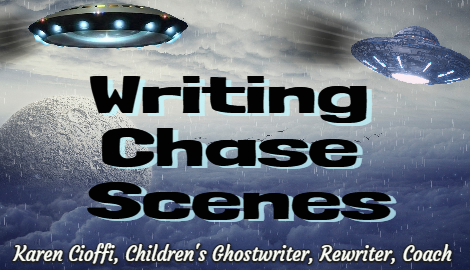Contributed by Carolyn Howard-Johnson Author of the award-winning HowToDoItFrugally Series of books for writers This article is excerpted from some editing I did for a writer of experimental fiction when I was on a Greater Los Angeles Writers Society (GLAWS) panel and focuses on writing chase scenes. No matter what genre you prefer, you can apply these suggestions to the chase, getaway, or high action scene in your script or manuscript. Do it before you send it to an agent or publisher or, better still, while you are writing the first draft. Sometimes even the most fascinating, interesting and irresistible detail can slow down the forward movement of your story. So as much as writers are told that detail is important, purge as much as you can from your action scenes and put it somewhere else or dribble it into narrative in other places in your manuscript. In the process, ask yourself if your reader really needs to know the color of the protagonist’s eyes. As important as detail is, some is better left to the imagination of the reader. I can imagine where eye color might be very important--even in that moment--but, on average, it probably isn’t necessary. It more likely it will take your reader out of the moment, maybe even make her laugh when you want her to be tense. Here are some quick suggestions: 1. Remove some of the detail entirely. Double check. Make it meet the test! 2. Use stronger verbs—especially verbs of movement. Use a Thesaurus to explore related words. 3. Use shorter sentences. By doing so, the rhythm could emulate a fast-beating heart and the pulse of danger. Note that clauses slow copy as surely as passive voice (or tense). 4. In the interest of a faster pace, try dropping into present tense and moving out of it when the run or danger is past. Write the scene that way and wait a day or two before rereading it. By doing so, you’ll be able to honestly compare the effects of the two and adjust the tense change so it doesn’t feel obtrusive. 5. If you are trying to achieve a truly heart-beating moment, consider using fragments. Even one-word fragments. 6. Commas can slow the pace. Sometimes you must follow grammar rules for commas for clarity. Often that comma slows things down for the reader. Does the comma indicate a pause where the reader wouldn’t normally pause or does it reinforce a natural pause? Does it really help with clarity? Would you achieve this clarity better if you made your long sentence into short ones. Don’t assume that because grammar rules would indicate a pause in normal prose, this isn’t normal. Pausing probably isn’t in the picture if one is running for his life. This is a style choice you get to make. You are looking for the times readers will never notice a comma is absent. You may choose to discard some of them even if it breaks a rule. 7. Consider saving the description of your protagonist for a time when life doesn’t depend on his or her speed. His “bright face of youth” doesn’t meet that test. Is there a way to work the major description into this narrative using smaller bites or to arrange to have it come before or after the chase? 8. Though I love sensory detail, be careful not to overdo that, especially in an action-moment. The writer of the action scene I was critiquing had the protagonist leaning against a strut for a moment’s rest. The strut’s sensory role in this passage should probably be the emotional reassurance it offered, not how it felt to the touch. Further, this kind of thing might best be left to your reader who will draw that conclusion anyway. 9. At the risk of being repetitious, the sense of danger shouldn’t be interrupted unless it is necessary for understanding. Sometimes that isn’t speed (like a chase). Sometimes it is. Regardless, you—the author—want to keep the momentum going for the reader. This article was previously published at: https://www.writersonthemove.com/2021/05/how-to-write-chase-scene-that-works.html ABOUT THE AUTHORCarolyn Howard-Johnson is the author of the multi award-winning series of HowToDoItFrugally books for writers including USA Book News’ winner for The Frugal Book Promoter. An instructor for UCLA Extension's renowned Writers Program for nearly a decade. Two of her favorite awards are Woman of the Year in Arts and Entertainment given by members of the California Legislature and Women Who Make Life Happen, given by the Pasadena Weekly newspaper. She is also an award-winning poet and novelist and she loves passing along the tricks of the trade she learned from marketing those so-called hard-to-promote genres. Learn more and find tons of free resources on her website at https://HowToDoItFrugally.com or on her Amazon profile page: https://bit.ly/CarolynsAmznProfile. While you’re there, click on the follow button and then make sure your own Amazon profile page is up-to-date. If you need help with that, check out my The Frugal Book Promoter, 3rd Edition, published by Modern History Press.

I’m a working children’s ghostwriter, rewriter, editor, and coach. I can help turn your story into a book you’ll be proud to be the author of, one that’s publishable and marketable.
OTHER HELP I OFFER:
HOW TO WRITE A CHILDREN’S FICTION BOOK
A DIY book to help you write your own children’s book.
PICTURE BOOK AND CHAPTER BOOK COACHING
Four to ten-week coaching programs.
WRITERS ON THE MOVE PRESS.
Self-publishing help for children’s authors.
You can contact me at: kcioffiventrice@gmail.com. Or give me a call at 347—834—6700. (Please leave a message- I’ll get back to you as soon as I can.)

